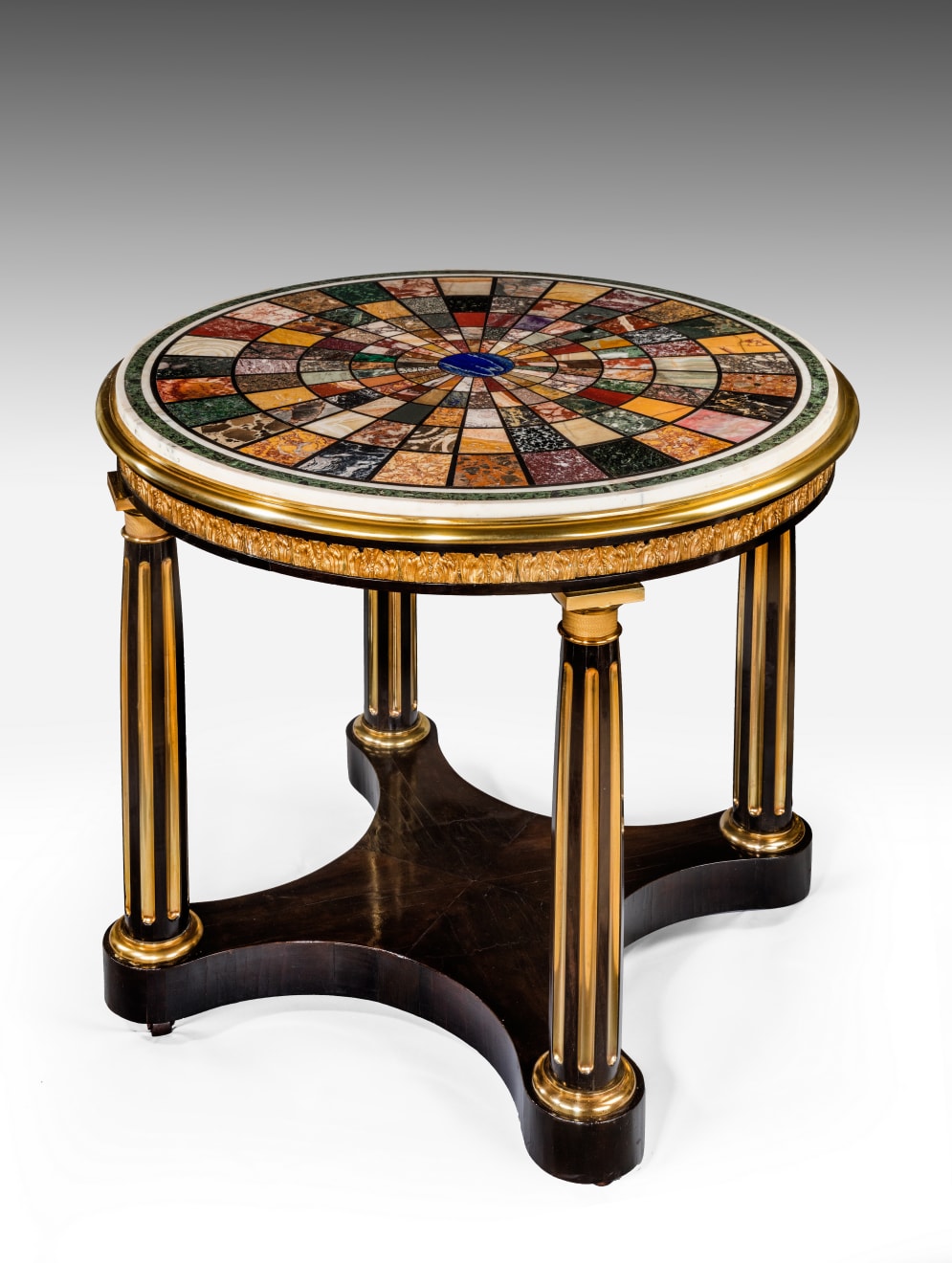George IV Gilt-bronze Mounted Ebony Centre Table with original Roman specimen marble top
ENGLAND, circa 1825
Inlaid hardstone table top: ROME, ITALY
90 x 83 x 83 cm
Further images
Provenance
By family descent to Mary Evelyn Hungerford Crewe-Milnes, Duchess of Roxburghe, most probably inherited from her parents as part of the furnishings at West Horsley Place. Her mother, Peggy Primrose, was the daughter of British Prime Minister Earl of Rosebery and his wife Hannah Rothschild; and her father was the Marquess of Crewe.The circular table top inlaid with a radial display of concentric bands of hardstone and marble specimens, including a lapis lazuli centerpiece. Set above a moulded and cast brass acanthus frieze, raised on four columns, fluted with gilt metal and headed by Tuscan capitals. The whole supported on and united by a shaped platform base.
In her chapter on ‘Tables’ in ‘Hardstones: The Gilbert Collection’, Anna Maria Massinelli explains that such centerpieces, in this case with its large central stone of lapis lazuli, are characteristic of tabletops from Roman workshops (Anna Maria Massinelli, Hardstones: The Gilbert Collection, Philip Wilson Publishers, London, 2000). Anna Maria Massinelli states: ‘this feature usually consists of a slab of antique marble from an excavated site, surrounded by a frame inlaid with cartouches and shields combined in different ways. The decorative effect is heightened by the combination of silicic stones and pietre dure of different colours’ (p.73-4). She continues by clarifying that, from the second half of the eighteenth Century, the identification and collection of antique marbles became a principal interest in Rome, influencing the decoration of table tops, as sample tables became: ‘Rome’s most typical product’ (p.75).
Morel & Hughes (fl 1805 – 1826): The table is made in the manner of the royal furniture makers Morel & Hughes (fl 1805 – 1826), sharing both the style of their items and being very similar to other documented pieces by this firm. The earliest mention of Nicholas Morel is in the accounts of the Prince of Wales in 1795, where he appears as a creditor and may have been part of the team of Anglo-French craftsmen who worked for Henry Holland and Dominique Daguerre for a number of years. In around 1805, Morel was joined in business by Robert Hughes and from 1805 until 1826 the business was based at 13 Great Marlborough Street, London. Morel & Hughes supplied the Prince of Wales (later the Prince Regent) with numerous pieces for Brighton Pavilion and Carlton House, London; and they supplied items to the Earl of Mansfield, the 6th Duke of Bedford, the 2nd Marquess of Bath and the 3rd Duke of Northumberland, as well as to many other aristocratic patrons. In 1826, Morel’s partnership with Hughes ended. The following year, in 1827, Morel established a new partnership with George Seddon III (1796–1857).
The ebonised columnar base was a design which was often used by the firm. Morel & Hughes were enlisted to decorate and furnish Northumberland House for the 3rd Duke of Northumberland, and the pair designed new stands for many of his pietre dure cabinets. One of these – a George IV gilt-bronze-mounted gonçalo alves stand which was used to mount a marble inlaid cabinet – has similar features to this table (see ‘Treasures: Including selected works from the Collections of the Dukes of Northumberland’, Sotheby’s, London, 9 July 2014, lots 4 and 11). This demonstrates the escalating taste for Anglo-French neo classicism, which the firm later became renowned for. Morel’s apparent French background evidently contributed to his work being held in high demand by the fashionable society of the time.
A similar circular marble table top, consisting of ancient Roman Marbles, is housed in the collection of the Natural History Museum, London (Image ID: 022882). This Roman table top is inlaid with large variety of ornamental marble excavated from tombs on Appian Way, a road constructed from Rome to Capua by Appius Claudius Caecus in 312 BC.
Duchess of Roxburghe (1915-2014): Mary Evelyn Hungerford Crewe-Milnes, Duchess of Roxburghe, was born in 1915 at Crewe House, Mayfair, her family’s London home. She was born into a world of tradition and high society, and her godmother was Queen Mary, after whom she was named. Her mother, Peggy Primrose, was the daughter of British Prime Minister Earl of Rosebery and his wife Hannah Rothschild; and her father was the Marquess of Crewe. Mary was their second child, but their only surviving child. In 1935, Mary married the Duke of Roxburghe, and moved to Floors Castle, an estate on the Scottish borders. Eighteen years later, the couple divorced and Mary moved to Hyde Park Gardens. In 1967, on her mother’s death, she inherited West Horsley Place, a mansion and estate near Leatherhead in Surrey.
Morel and Seddon handled work crafted by Adam Weisweiler (1744–1820), who was Louis XVI’s leading ébéniste, or cabinetmaker. A rectangular cabinet by Adam Weisweiler, which is in the Royal Collection Trust (RCIN 2593), is dated circa 1790, veneered with ebony, and set with three pietra dura panels of flowers and birds (illustrated in Hugh Roberts, ‘For the King’s Pleasure’, Fig. 246, p.209). This cabinet was part of the group of furniture and furnishings supplied between 1827 and 1829 to King George IV by the partnership of Morel and Seddon for the bedroom at Windsor Castle. This cabinet was restored by Morel & Seddon at a cost of £178.17. Morel & Seddon provided new locks and brass flutes for the legs and replaced the missing stones (Morel & Seddon accounts, fo.124). The cabinet has very similar fluted columns.
Hugh Roberts also illustrates an English satinwood and specimen marble writing table, circa 1790, with similar fluted columns (Hugh Roberts, ‘For the King’s Pleasure‘, Fig. 281, p.232). This table was part of the group of furniture and furnishings restored and supplied between 1827 and 1829 to King George IV by the partnership of Morel & Seddon for The Drawing Room at Windsor Castle.












